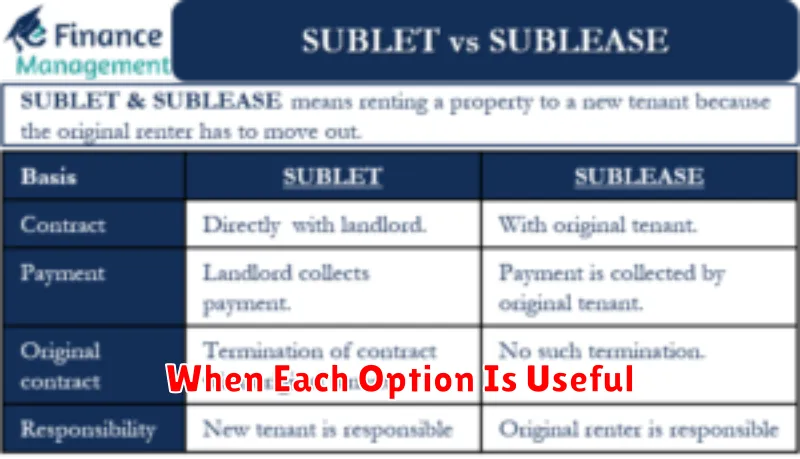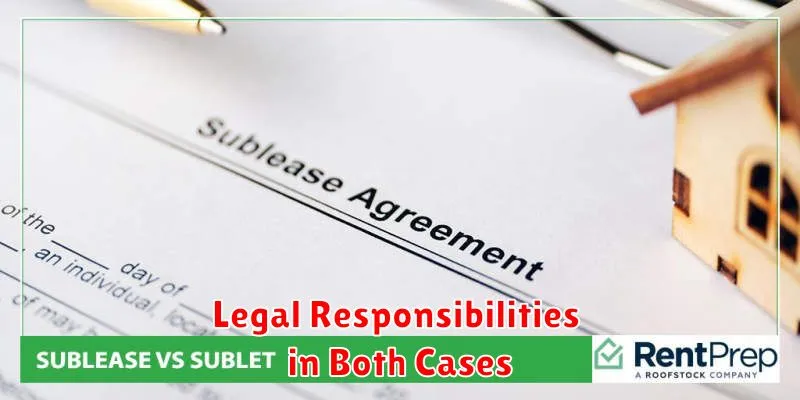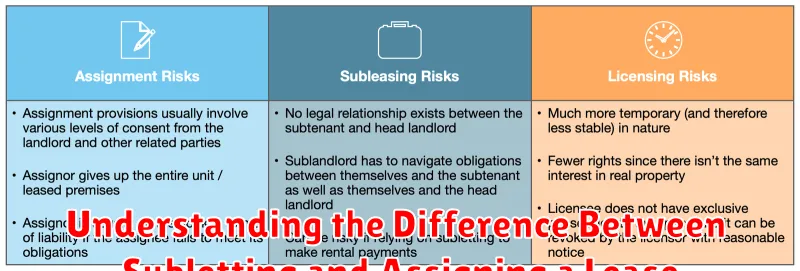Understanding the nuances between subletting and assigning a lease is crucial for both tenants and landlords. Whether you’re looking to transfer your lease obligations temporarily or permanently, knowing the difference can save you from potential legal and financial headaches. This article will explore the key distinctions between subleasing and lease assignment, outlining the respective responsibilities and implications for all parties involved. We will delve into the specifics of each process, including required documentation, potential liabilities, and common scenarios where one option might be preferable over the other. This knowledge will empower you to make informed decisions and navigate the complexities of lease transfers with confidence.
Navigating the world of rental agreements can be challenging, particularly when considering options like subleasing vs. assigning a lease. Choosing the correct method of transferring your leasehold interest depends on various factors, including the length of time you plan to be away, your landlord’s policies, and local laws. This guide will provide clarity on the critical differences between a sublease agreement and a lease assignment agreement, focusing on the practical implications for both landlords and tenants. By understanding these distinctions, you can ensure a smooth transition and avoid potential conflicts down the road.
What Is Subletting?
Subletting is the act of renting a property (or a portion of a property) from a tenant, rather than directly from the landlord. The original tenant, also known as the sublessor, retains their lease agreement with the landlord but grants occupancy rights to a new tenant, called the subtenant or sublessee. It’s crucial to remember that the original tenant remains ultimately responsible for upholding the terms of the original lease, including rent payment and property maintenance.
Subletting arrangements require the consent of the landlord, as stipulated in most lease agreements. Without explicit permission from the landlord, subletting is typically prohibited and can lead to serious consequences, including eviction. Landlords may have specific criteria or procedures for approving subtenants, such as background checks and interviews.
Subleases can be for a portion of the original lease term or for the remainder of the lease. The terms and conditions of the sublease agreement, including rent amount and responsibilities, should be clearly outlined in a written contract between the sublessor and the sublessee. This contract, while separate from the original lease, should not conflict with the original lease’s terms.
What Does Assigning a Lease Mean?
Assigning a lease means transferring the entire remaining term of your lease agreement to a new tenant, called the assignee. This essentially removes you from the legal obligations of the lease, replacing you with the assignee. The assignee becomes responsible for paying rent, maintaining the property according to the lease terms, and fulfilling all other obligations outlined in the original agreement. It’s important to understand that while you may be released from legal responsibility, some leases contain clauses that hold the original lessee liable if the assignee defaults.
The assignment process typically requires the landlord’s consent. They may have specific criteria for approving a new tenant, such as credit checks and income verification. The landlord may also require you to remain a guarantor, meaning you are still financially responsible if the assignee fails to meet their lease obligations. A lease assignment is different from subletting, where you rent out the property to a subtenant but remain ultimately responsible for the lease terms and payments to the landlord.
Before assigning your lease, carefully review your lease agreement and consult with your landlord. Understanding the specific terms and conditions related to assignment, as well as any potential financial implications, is crucial for a smooth and legally sound transfer of the lease.
When Each Option Is Useful

Understanding when to use formal versus informal language is crucial for effective communication. Formal language is generally used in professional, academic, or official settings. Think business letters, research papers, and legal documents. It emphasizes clarity, objectivity, and adherence to grammatical rules. Informal language, on the other hand, is appropriate for casual communication with friends, family, or colleagues in a relaxed setting. It prioritizes ease of understanding and connection over strict adherence to rules.
Choosing the appropriate level of formality also depends on your audience and purpose. When addressing a superior, a client, or a large, unfamiliar group, formal language demonstrates respect and professionalism. Conversely, informal language can build rapport and create a more friendly atmosphere when communicating with peers or close acquaintances. When the goal is to convey complex information accurately, formal language minimizes ambiguity. For building relationships or expressing personal thoughts, informal language allows for greater emotional expression.
Consider the medium as well. Formal writing is expected in emails to clients, official reports, and academic submissions. Informal writing is common in text messages, social media posts, and personal emails. Ultimately, the key is to be adaptable and mindful of the context to ensure your message is received as intended.
Legal Responsibilities in Both Cases

When discussing legal responsibilities, it’s crucial to understand the context. Whether it’s a civil or criminal case, distinct obligations arise for all parties involved. In civil cases, the focus is on resolving disputes between individuals or entities, often involving contracts, property, or torts (like negligence). The plaintiff bears the burden of proving their case by a preponderance of the evidence, meaning it’s more likely than not that the defendant is liable. The defendant’s responsibility is to mount a defense against the claims. Consequences typically involve financial remedies, such as damages or specific performance.
Criminal cases, on the other hand, involve alleged violations of statutes, where the government prosecutes individuals or entities for offenses against the public. The prosecution must prove guilt beyond a reasonable doubt, a significantly higher standard of proof than in civil cases. The defendant’s fundamental right is to be presumed innocent until proven guilty and to receive a fair trial. Penalties in criminal cases can include fines, incarceration, probation, and other sanctions.
In both civil and criminal cases, due process is paramount. This guarantees fundamental fairness and requires notice of the proceedings and an opportunity to be heard. While legal representation isn’t strictly mandatory in every situation, it’s strongly advised to seek the counsel of an attorney. Understanding the specific legal responsibilities in each case is critical to navigating the legal system effectively.
Getting Approval from Your Landlord
Getting your landlord’s approval for anything requires clear and respectful communication. Begin by putting your request in writing, clearly stating what you’re asking for (e.g., a pet, a roommate, renovations). Include relevant details like dates, times, and contact information. Be prepared to provide any necessary documentation, such as pet vaccination records or roommate references. This demonstrates your seriousness and responsibility.
Understand your lease agreement. Review it carefully to ensure your request doesn’t violate any existing clauses. Highlighting how your request aligns with the lease terms strengthens your case. If necessary, propose solutions to potential concerns your landlord might have. For example, if you’re requesting a pet, offer to pay a pet deposit or provide proof of pet insurance.
Maintain open communication with your landlord throughout the process. Be responsive to their questions and willing to compromise where possible. A positive and cooperative attitude can go a long way in securing their approval. Remember to follow up after submitting your request to confirm receipt and inquire about a timeline for their decision.
Common Pitfalls to Avoid
When undertaking a new project or task, it’s crucial to be aware of potential pitfalls that can hinder progress and success. Planning is paramount. Failing to adequately plan can lead to wasted time, resources, and ultimately, project failure. A thorough plan should outline objectives, timelines, resource allocation, and potential risks. Additionally, neglecting communication can create misunderstandings and conflicts among team members. Open and frequent communication is essential for ensuring everyone is on the same page and working towards a shared goal.
Another common pitfall is scope creep. This occurs when the project’s scope expands beyond its original parameters, often without corresponding adjustments to the timeline or budget. Scope creep can quickly derail a project and lead to significant delays and cost overruns. Clearly defining the project scope upfront and establishing a process for managing change requests is essential for mitigating this risk. Risk assessment is also critical. Failing to identify and address potential risks can leave a project vulnerable to unforeseen challenges.
Finally, avoid the trap of micromanagement. While oversight is important, excessive control can stifle creativity, demotivate team members, and hinder productivity. Trusting your team’s expertise and empowering them to take ownership of their work will lead to better results. Focus on providing guidance and support rather than dictating every detail. Remember, a successful project relies on collaboration and effective leadership.
Tips for Smooth Lease Transfers
Transferring a lease can be a complex process, but with careful planning and open communication, it can be handled smoothly. First, review your current lease agreement thoroughly to understand the specific terms and conditions regarding lease transfers. Many leases require written consent from the landlord, and some may stipulate specific procedures or fees. Early communication with your landlord is crucial. Explain your reasons for transferring the lease and provide them with all necessary information about the proposed new tenant, including their credit history and rental application. By being proactive and transparent, you can build trust and facilitate a smoother transition.
Thoroughly screening potential tenants is vital for a successful lease transfer. If your landlord allows you to find a replacement tenant, be sure to conduct a thorough background check and verify their income and rental history. Providing your landlord with a well-qualified candidate will increase the likelihood of approval. Once a suitable tenant is found, ensure all the necessary paperwork, including the lease transfer agreement, is completed accurately and signed by all parties involved. Keep copies of all documents for your records.
Finally, clearly communicate all details of the transfer to the new tenant. This includes explaining the terms of the lease, any existing issues with the property, and procedures for rent payment and maintenance requests. A clear understanding from the beginning will help prevent misunderstandings and ensure a positive rental experience for everyone involved.

